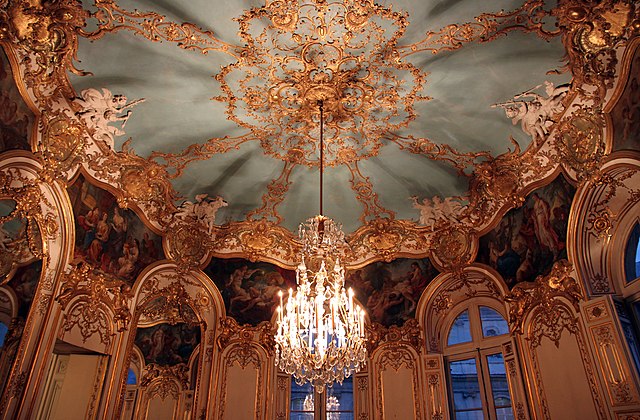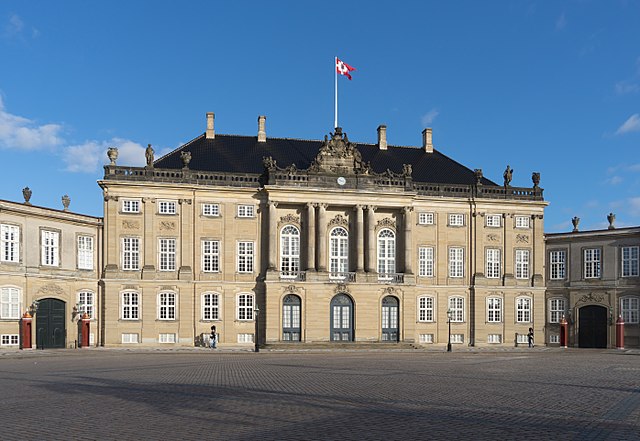The Rococo architecture style emerged from Europe in the 18th century and was recognized as one of the most distinct of any other movement since the Italian Renaissance era.
The Rococo style was one defined by elaborate, theatrical presentations that were much more pronounced than anything found in the Baroque style that preceded it.
Rococo art and architecture seemed to celebrate every little curve or color accent, which was perfectly in congruence with the cultural mindset of those living in Paris, France in the beginning of this movement.
In this article, we’ll examine 10 of the most famous Rococo architecture works and take a closer look at the designers responsible for each one, as well as their purpose.
Famous Rococo Architecture
1. Sanssouci Palace

The Sanssouci Palace is one of the most historic structures in all of Europe as it signifies a unique point in history in which German architects sought to create a building that was somewhat equal to the wonder and beauty of Versailles in France.
This palace is located in the city of Potsdam near Berlin, Germany and was originally built to serve as a summer home for the Prussian King, Frederick the Great.
The grandeur and serene beauty of the surrounding countryside led architects and those within the royal kingdom to bestow it with the name, Sanssouci Palace, which translates to “Palace of No Worries.”
The design for the palace was developed by Georg Wenzeslaus von Knobelsdorff, who was a widely acclaimed painter and architect throughout the Prussian kingdom during the mid-18th century.
Von Knobelsdorff worked on the design for more than a decade, but would eventually not be allowed to see it through to completion after having disagreements over the specific location where the palace would be built. Jan Bouman was appointed to oversee the project and did so until it was completed in 1745.
2. Salon de Monsieur le Prince, Chantilly

Another one of the world’s notable structures that many consider to be among the most famous Rococo architecture works is the Salon de Monsieur le Prince, Chantilly.
This sprawling palace is situated in the town of Chantilly, Oise, which is roughly 30 miles north of Paris.
The Salon de Monsieur le Prince, Chantilly is known as one of the most historic buildings in France and it was originally built in 1560 for Anne de Montmorency and was known as the Petit Château.
This structure was destroyed during the French Revolution and was rebuilt in the decades to follow by Henri d’Orléans, Duke of Aumale.
The project of rebuilding and redesigning the once-great palace was carried out by Jean Bullant and Honoré Daumet, who are recognized as two prominent architects from the late 19th century in France.
The Salon de Monsieur le Prince, Chantilly was finally completed in 1882 and the building featured much more pronounced Rococo themes and characteristics than before.
3. Amalienburg, Munich

One striking characteristic of most Rococo buildings is the over-the-top design of the structure’s interior compared to the exterior. Such is the case for the Amalienburg, Munich, which is said to be another masterpiece of Rococo architecture.
This relatively small building is not lacking the elaborate and theatrical details that many other Rococo buildings were designed with during the 19th century.
The Amalienburg, Munich is said to have been designed as a hunting lodge between 1734 and 1739 for Elector Karl Albrecht, who went on to become Holy Roman Emperor Charles VII and his wife, Maria Amalia of Austria.
The small, but impressive structure was designed by Johann Baptist Zimmermann and Joachim Dietrich, who were both recognized as two of the Holy Roman Empire’s greatest architects during the mid-18th century.
4. Linderhof Palace, Bavaria

Linderhof Palace is a sprawling estate that is nestled in the forested hills of Bavaria near the small village of Ettal.
This structure is one of three palaces that was built by King Ludwig II of Bavaria and would eventually become the only one of the three buildings that the king ever saw completed during his lifetime.
Its elaborate design is consistent both inside and out as the palace’s stone facade overlooks a serene pool that is highlighted by a pair of golden statues in the center of the water.
Ludwig II would demolish the palace that existed on the property after the death of his father, Maximilian II of Bavaria. He built the newly-designed Linderhof Palace, Bavaria in 1874 using architects who were well-versed in the Rococo style of building.
The project would take a years to complete and a total expense of more than 8.4 million marks was invested into Linderhof Palace, Bavaria before it was completed.
5. Catherine Palace, Saint Petersburg

The Rococo movement flourished throughout Europe during the 18th century and mostly became popular among royal families and those with elite status who had the financial means to construct such elaborate buildings.
Also Read: Famous 18th Century Architects
The Rococo style would also be featured in Russia’s city of Saint Petersburg in a structure that is known as Catherine Palace. The actual location of Catherine Palace is in Tsarskoye Selo, which is nearly 30 kilometers south of the city of Saint Petersburg.
After Russia’s Great Northern War, Peter the Great would give the estate to this wife, Catherine. The property was then known as Saari Mojs, which translates in Russian to “a high place.”
A little more than a decade after Catherine had received this estate, the palace was designed and built by Johann Friedrich Braunstein and Johann Ferster.
The large, two-story building was heavily-influenced by Rococo architectural style and Ferster and Braunstein incorporated various impressive elements to the interior that was sure to impress Catherine’s royal guests.
6. Salons of the Hotel de Soubise, Paris

The Salons of the Hotel de Soubise, Paris is considered to be one of the most historic structures in the French capital city, but it’s also one that features a great amount of Rococo architectural influence as well.
The hotel building was initially built during the 14th century and stood for many years before renovations were needed during the early 1700’s. The structure had been built for the Prince and Princess de Soubise on an already-existing house that was known as the Grand-Chantier.
Historians say that the hotel had formerly been a property of the Knights Templars and other prominent groups. The building’s remodeling effort during 1735 to 1740 included a significant amount of Rococo architectural designs, which were included in the building’s construction.
These interior modifications have made the Salons of the Hotel de Soubise, Paris one of the most famous Rococo buildings in the world today.
7. Czapski Palace, Warsaw

The Czapski Palace, Warsaw is a moderately-large and dignified palace located in the heart of Warsaw, the capital city of Poland.
Much of the building’s design was planned and carried out by Tylman Gamerski, who is recognized as one of the most famous architects in Poland’s history.
The exterior of the Czapski Palace features very little Rococo architecture, but the interior is filled with a wide variety of different Rococo influences and styles that Gamerski undoubtedly included at the behest of the royal family.
These Rococo influences were done under the guidance of the Czapski family from 1752 to 1765.
8. Amalienborg Palace, Denmark

One of Denmark’s most famous buildings is the Amalienborg Palace, which is home to the nation’s royal family.
Located in Copenhagen, Denmark, the Amalienborg Palace is another example of Rococo architecture that was carried out during the eventful and often-tumultuous 18th century in Europe.
The estate features four different palaces, which are all situated along the coast and have a view overlooking the waters of the sea near Copenhagen. In the center of the four buildings is a large equestrian statue of Amalienborg’s founder, King Frederick V.
Work on the palace began in 1750 and the four different buildings were all completed one decade later in 1760.
The Amalienborg Palace often housed royal families from Denmark and other countries until the end of the 18th century. Today, it is used as a historic site, as well as lodging for prominent guests to the city.
9. Charlottenburg Palace, Berlin

Charlottenburg Palace, in Berlin is often considered to be one of the most impressive palaces in Germany that remain unscathed by world wars and other conflicts over the last few centuries. The Charlottenburg Palace is located in Charlottenburg-Wilmersdorf and is often recognized for the Baroque style exterior. However, the building’s interior is brimming with Rococo features.
Many of the interior’s halls and rooms are full of Rococo artwork and the highly-decorative style that was so well-known during the 18th century.
10. Branicki Palace, Warsaw

Another famous Rococo architectural work is also found in Warsaw, Poland. The Branicki Palace was built from 1740 to 1753 and was said to be one of the best examples of Rococo architecture known to exist in Europe in the years that followed.
Unfortunately, the entirety of that Rococo architecture now exists only in paintings as the building was destroyed during World War II by the invading German forces.

